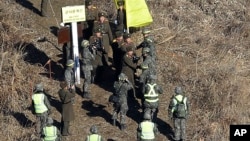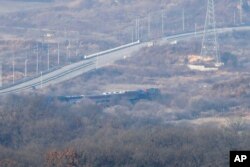Soldiers from North and South Korea criss-crossed their heavily-fortified border Wednesday to inspect efforts to remove front-line guard posts from their respective sides.
Inspection teams from South Korea were greeted by North Korean soldiers when they stepped into the Demilitarized Zone early Wednesday, both sides exchanging handshakes and cigarettes before the South Koreans crossed the border to begin their inspections.
The South Koreans visited 11 North Korean guard posts to make sure they had either been dismantled or disarmed, and if any underground structures were left undestroyed. North Korean inspection teams crossed the border hours later to perform similar inspections on 11 South Korean border posts.
Despite Wednesday's action, about 200 manned guard posts still remain along the DMZ.
The border is the world's most heavily fortified, filled with millions of landmines and marked by long lines of barbed wire fences.
The dismantling of the guard posts in the DMZ was part of a comprehensive military agreement reached between South Korean President Moon Jae-in and North Korean leader Kim Jong Un during their third summit in September at Pyongyang.
The agreement, which is aimed at reducing military tensions on the Korean peninsula, included disarming the Joint Security Area - commonly referred to as the truce village of Panmunjon - including the removal of all landmines, guard posts, surveillance and other military equipment. They also agreed to reduce the number of personnel stationed at the JSA to just 35 unarmed guards, with the aim of reshaping it into a tourist attraction.
The Joint Security Area, controlled by both Seoul and Pyongyang along with the U.S.-led United Nations Command, is the only spot within the 250-kilometer-long DMZ where troops from North and South Korea stand face-to-face. The three sides have controlled the area since the end of the Korean War in 1953, leaving North and South Korea in a technical state of war.















